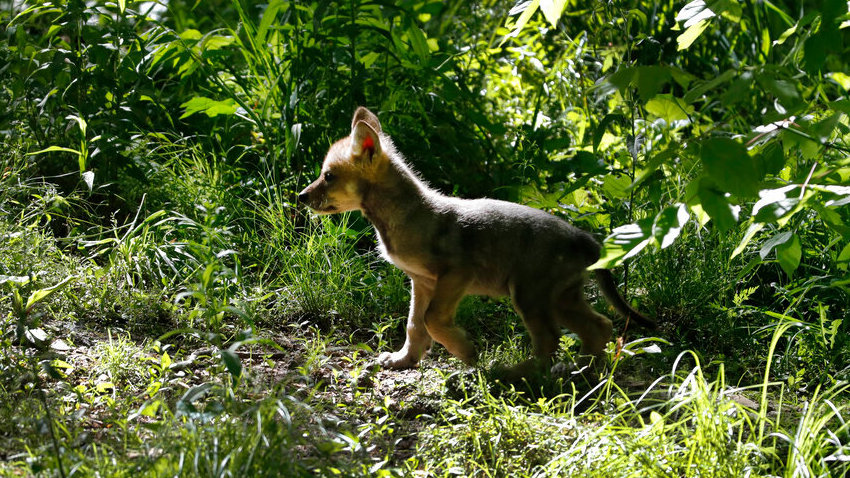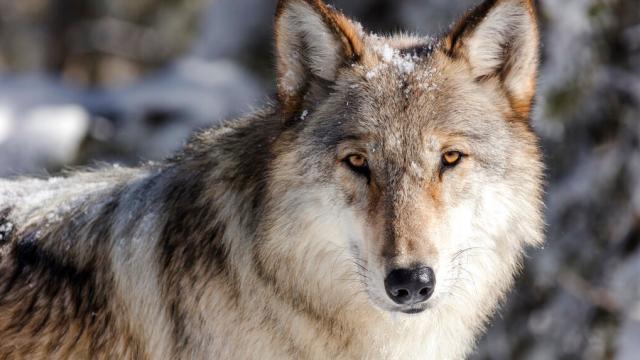Two prevailing theories exist about the origin of domesticated dogs. One proposes that prehistoric humans used early dogs as hunting partners, and the other says that wolves were attracted to our garbage piles. New research suggests both theories are wrong and that the real reason has to do with our limited capacity to digest protein.
Dogs were domesticated from wild wolves during the last ice age between 14,000 and 29,000 years ago, and they were the first animals to be domesticated by humans. That humans and wolves should form a collaborative relationship is an odd result, given that both species are pack hunters who often target the same prey.
“The domestication of dogs has increased the success of both species to the point that dogs are now the most numerous carnivore on the planet,” wrote the authors of a new study published today in Scientific Reports. “How this mutually beneficial relationship emerged, and specifically how the potentially fierce competition between these two carnivores was ameliorated, needs to be explained.”
Indeed, given this context, it’s not immediately obvious why humans would want to keep wolves around. Moreover, the two prevailing theories about the origin of dogs — either as partners used for hunting or as self-domesticated animals attracted to our garbage — aren’t very convincing. Wolves, even when tamed, would’ve made for awful hunting partners, as they lacked the collaborative and advanced communication skills found in domesticated dogs. And sure, wild wolves were probably attracted to human scraps, but this would’ve required some unlikely interactions between humans and wolves.
“In our opinion, the self-domestication in this way is not fully explained,” Maria Lahtinen, a chemist and archaeologist at the Finnish Food Authority in Finland and the first author of the new study, said in an email. “Hunter-gatherers do not necessarily leave waste in the same place over and over again. And why would they tolerate a dangerous carnivore group in their close surroundings? Humans tend to kill their competitors and other carnivores.”
Lahtinen and her colleagues say there’s a more likely reason for the domestication of dogs, and it has to do with an abundance of protein during the harsh ice age winters, which subsequently reduced competition between the two species. This in turn allowed humans and incipient dogs to live in symbiotic harmony, paving the way for the ongoing evolution of both species.
The researchers have “introduced a really interesting hypothesis that seeks to address the long-debated mechanism by which early dog domestication occurred,” James Cole, an archaeologist at the University of Brighton who’s not involved with the new study, wrote in an email. “The idea is that human populations and wolves could have lived alongside each other during the harsh climatic conditions [of the last ice age] because human populations would have produced enough protein, through hunting activities, to keep both populations fed during the harsh winter months.”
Seems hard to believe, but humans likely had more food during ice age winters than they could handle. This is due to our inability to subsist exclusively on lean protein for months at a time — something wolves have no issues with. For humans, excessive consumption of protein can lead to hyperinsulinemia (insulin resistance), hyperammonia (excess ammonia in blood), diarrhoea, and in some extreme cases even death, according to the authors. To overcome this biological limitation, Pleistocene hunters adapted their diets during the winter months, targeting animal parts rich in fat, grease, and oils, such as lower limbs, organs, and the brain. And in fact, “there is evidence for such processing behaviour during the Upper Palaeolithic,” according to the paper.
Consequently, wolves and humans were able to “share their game without competition in cold environments,” said Lahtinen. This in turn made it possible for humans to keep wolves as pets.
“Therefore, in the short term over the critical winter months, wolves and humans would not have been in competition over resources and may have mutually benefited from each other’s companionship,” wrote the authors. “This would have been critical in keeping the first proto-dogs for years and generations.”

It’s very possible, said Lahtinen, that the earliest dogs were wolf pups. Hunter-gatherers, she said, “do take pets in most cultures, and humans tend to find young animals cute,” so it would “not be a surprise if this would have happened.”
So dogs exist because wolf pups were cute and we had plenty of leftovers? Seems a legit theory, if you ask me.
Only later, due to traits introduced by artificial selection, were dogs used for hunting, guarding, pulling sleds, and so on, according to the researchers. This theory may also explain the complexity of early dog domestication, which appears to have occurred in Eurasia at multiple times, with dogs continuing to interbreed with wild wolves. The new theory may also explain why the domestication of dogs appears to have occurred in arctic and subarctic regions.
As for the summer months, that wasn’t as crucial for humans, given the relative abundance of food alternatives. During the critical winter months, however, “hunter-gatherers tend to give up their pets if there is a need to give up resources from humans,” said Lahtinen.
Importantly, Lahtinen and her colleagues did not pull this theory from thin air. To reach this conclusion, the team performed energy content calculations to estimate the amount of energy that would be left over from prey animals also hunted by wolves, such as deer, moose, and horses. The authors reasoned that, if humans and wolves were having to compete for these resources, there would be little to no cooperation between the two species. But their calculations showed that, aside from animals like weasels, all animals preyed upon by humans would have provided more lean protein than required.
[referenced id=”1034776″ url=”https://gizmodo.com.au/2017/04/ancient-humans-didnt-turn-to-cannibalism-for-the-calories/” thumb=”https://gizmodo.com.au/wp-content/uploads/2017/04/06/hkgqaoqg7f1wlascopcf-300×185.jpg” title=”Ancient Humans Didn’t Turn To Cannibalism For The Calories” excerpt=”Humans have been eating other humans since the beginning of time, but the motivations behind this macabre practice are complex and often unclear. Some anthropologists say prehistoric cannibals were just trying to grab a nutritious snack, but new research shows that human flesh — as tasty as it is —…”]
“Therefore, the early domesticated wolves could have survived living alongside human populations by consuming the excess protein from hunting that humans could not,” explained Cole. “By having enough food for both populations, the competitive niche between the species is eliminated, thereby paving the way to domestication and the benefits of such a relationship to the two species.”
Cole described it as a “really intriguing hypothesis” because it provides a “mechanism that can explain the domestication of the wolf across a wide geographic and temporal range,” and it does so by “explaining how two carnivorous species could overcome the competition…under harsh climatic conditions.” Looking ahead, Cole said a similar approach would be useful for studying the interactions of humans and other species on this planet over time.
As a relevant aside, Cole is the author of a fascinating Scientific Reports paper published in 2017 arguing that ancient humans didn’t turn to cannibalism for nutrition. Using an approach similar to the one taken in the Lahtinen paper, Cole showed that human flesh simply doesn’t pack the same amount of calories as wild animals, and cannibalism wouldn’t have been worth all the trouble.
